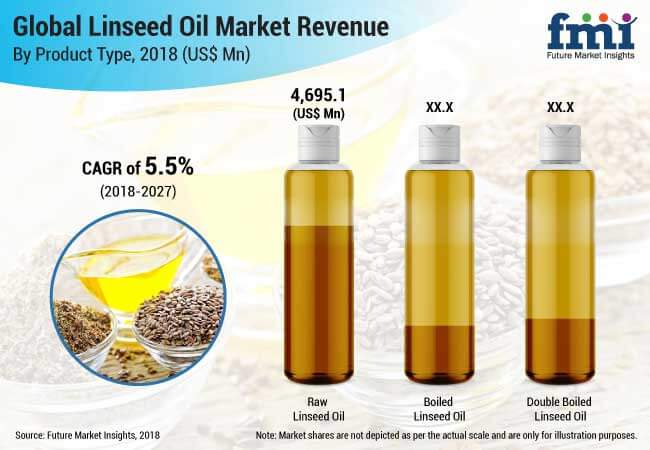In ancient Egypt, the flax plant was cultivated by the ancient Egyptians to produce linen out of the lignan abundantly present in the plant stem, which was used to wrap mummies. Linseed oil is extracted from the seeds of the flax seed using the extraction or pressing method. For thousands of years, linseed has been consumed as a food and also used as a remedial medicine. According to a new study by Future Market Insights, consumer demand for linseed oil is anticipated to experience a meteoric rise, aided by the high content of the omega-3 fatty acids, among the health conscious populace, globally.
Request a Sample Report with Table of Contents and Figures: https://www.futuremarketinsights.com/reports/sample/rep-gb-8137
Linseed oil is a rich source of essential fatty acids such as omega-3 fatty acids and omega-6 fatty acids. Moreover, it is high in fiber, low in carbohydrates, and is gluten-free. The fatty acids present in the typical linseed oil are α-linolenic acid (51.9-55.2%), palmitic acid (about 7%), stearic acid (3.4-4.6%), oleic acid (18.5-22.6%), and linoleic acid (14.2-17%). The global market for linseed oil can be summarized in three product types, namely, raw linseed oil, boiled linseed oil, and double-boiled linseed oil. With the latter two types, storage of the product poses a major threat for the linseed oil market, since linseed oil reacts with the surrounding oxygen and oxidizes easily. In this type of chemical reaction, heat is generated that can lead to spontaneous combustion. Traditionally, linseed oil is used for treating various conditions such as inflammation, infections, abscesses, etc. Most recent studies have shown that, linseed oil rich in α-linolenic acid promotes excellent wound healing properties in vitro. Linseed oil is gaining attraction as a superfood, due to the high content of omega-3 fatty acids, which aids in weight management and benefits the health. Linseed oil is generally not used for cooking purposes, unless it is food-grade, unprocessed, and pure linseed oil.

Linseed Oil Market Share Shifting from Industrial Use to Dietary Supplements
Up until World War II, the utilization of linseed oil was dominantly occupied by protective coating and other allied manufactured products such as linoleum, patent leather, oil clothing, etc. With extensive research and development, various alternatives are replacing the use of linseed oil in paints and varnishes. For example, the development of vinyl floor coverings replacing linoleum, latex interior paints replacing linseed oil in paint, cotton cloth replacing linen. However, with the advent of research and many technological developments, linseed oil has emerged as a dietary supplement, owing to the presence of omega-3 fatty acids, a polyunsaturated fatty acid. These fatty acids are beneficial in various ways, such as improving heart health, treating constipation and diarrhea, helping in weight management, reducing inflammation, rheumatoid arthritis treatment, and cancer treatment. With the increasing prevalence of chronic diseases all over the world, dietary supplements are experiencing a tremendous rise in demand, supporting an increase in global linseed oil demand. The global market for linseed oil is expected to gain significant momentum, and register a growth of 5.5% in terms of value between 2018 and 2027.
Surge of Linseed Oil in the Cosmetic Industry Bolstering Global Demand
The need for good looks to create a good impression has led to humongous growth in the cosmetic industry in recent times. European and Asian countries such as South Korea, Japan, China, Germany, and Switzerland have seen an enormous boom in the cosmetic industry. Linseed oil is used in moisturizers, creams, and skin and hair products as a source of an omega-3 fatty acid. According to FMI analysts, the global demand for linseed oil in the cosmetic industry is likely to boost the overall demand for linseed oil.
Organically Produced Linseed Oil to Attract the Millennial Generation
The use of chemicals for improved crop production yield has been confirmed to decrease the soil quality and overall productivity. Moreover, these chemicals enter into human body through consumed food. On the other hand, organically produced linseed oil crops tend to preserve the quality of the soil, and have an improved flavor and taste. Consumers are inclined to buy organic products that are marketed as supreme and premium quality products, even though they cost more as compared to conventionally produced linseed oil. Linseed oil manufacturers have successfully kept track of the current trend and consumer needs, and are turning away from using conventionally produced linseed oil.
Buy this report: https://www.futuremarketinsights.com/checkout/8137
Global Linseed oil Market: Segmentation
By Nature:
- Organic
- Conventional
By Product Type:
- Raw Linseed Oil
- Boiled Linseed Oil
- Double-boiled Linseed Oil
- Others
By Application:
- Dietary Food
- Pharmaceuticals
- Paint & Textile Industry
- Leather Industry
- Animal Feed
- Personal Care
- Processed Food
- Others
By Distribution Channel:
- Online Retailers
- Grocery Stores
- Wholesalers
- Supermarkets

